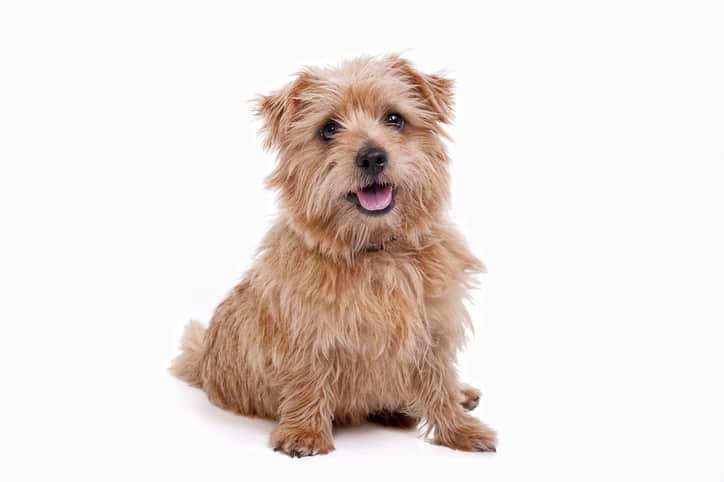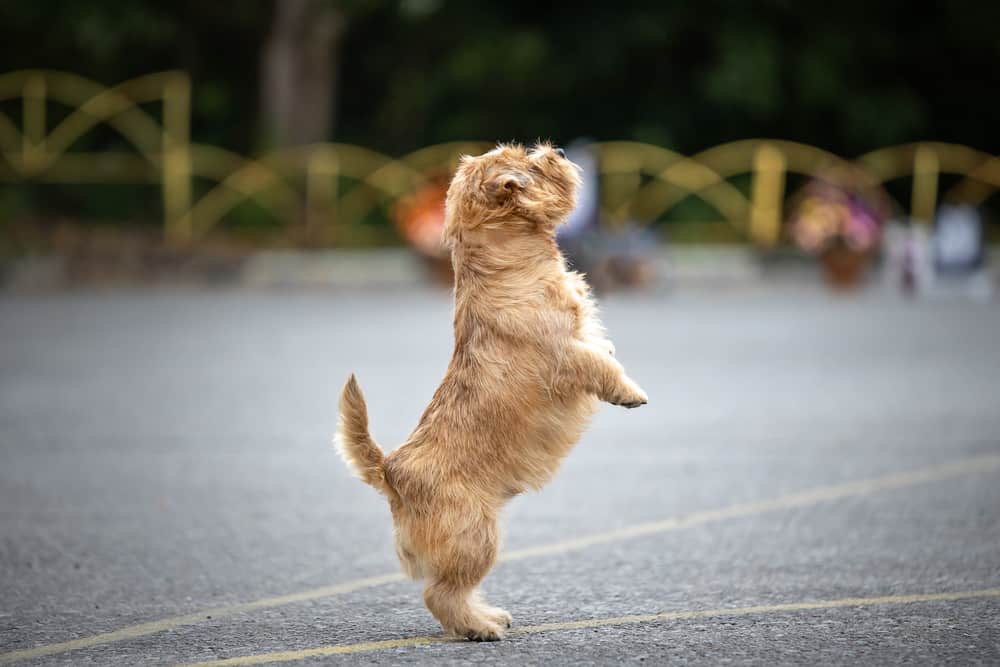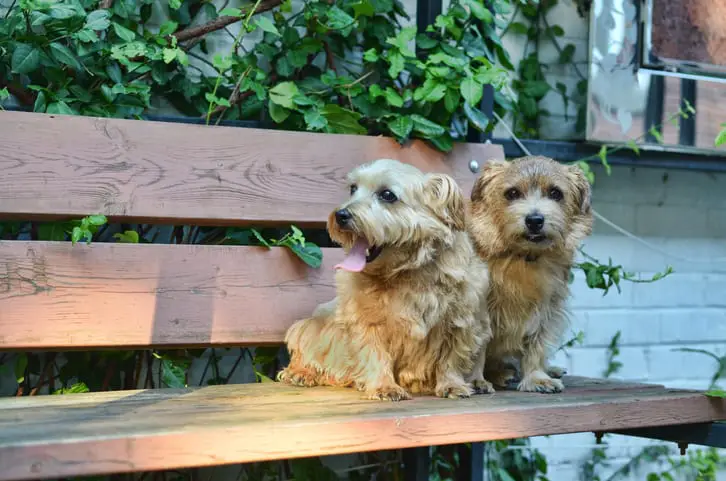Complete Guide To The Norfolk Terrier: Grooming, Personality, Health and More
Norfolk Terriers are fearless, fun-loving family dogs. Confident and loyal, they’re portable, pint-sized protectors with warm hearts and eyes for adventure.
Table of Contents
How Big Do Norfolk Terriers Get?
| Height | Weight | |
| Male | 10″ at the shoulder | 11-12 lbs |
| Female | 9″ at the shoulder | 11-12 lbs |

What Do Norfolk Terriers Look Like?
Norfolks are among the smallest terriers. Compact but sturdy, they weigh only 11-12 pounds and stand 9-10 inches tall. Their small triangular ears fall forward, highlighting a wedge-shaped muzzle and dark, sparkling eyes.
The Norfolk’s hard, wiry coat comes in four official colors, with or without black points, including:
• Black and Tan
• Red
• Red Wheaton
• Grizzle
White marks are a penalty in the ring. Their tails are typically docked to mid-length.
Norfolk Terriers are genetically influenced by similar breeds and are easily mistaken for their close cousin, the Norwich Terrier.
What Is The Personality Of A Norfolk Terrier?
Norfolks are the epitome of the spunky terrier. Playful, they’re a perfect fit for an active family with children. Bred to hunt, they’re social with other dogs but may chase smaller pets, including cats.
Doting, Norfolks enjoy quiet time with family, but they’re also energetic and curious to a fault. Unafraid and protective, they’re vocal and make formidable watchdogs despite their elfin size. Ideal for apartments, early training and socialization are important to prevent nuisance barking.
How Much Exercise Does A Norfolk Terrier Need?
Norfolk Terriers like to be on the go, but they’re not fussy about exercise as long as they’re doing it with you. A brisk, half-hour walk and a game of fetch are all they need to stay physically and mentally fit. Clever, Norfolks will entertain themselves if challenged, so offer them complex toys.

Prey-driven, they’ll take off after squirrels and cars — keep them on a leash or in a fenced-in yard. Ratters, they’re known to dig, so sink fences deep. Friendly with other dogs, they enjoy time at the park.
Check out our Canine sports articles to learn more about agility, flyball, barn hunt, and more!
How Much Grooming Do Norfolk Terriers Need?
Norfolk Terriers have a wiry double coat with a short, dense layer for warmth and a weather-resistant outer coat. Heavy, it requires special care to keep it in top condition.
Weekly brushing removes dirt, but hand-stripping is recommended for maintaining its texture and shine— it’s a lengthy process but one that owners can manage. Using your fingers and a stripping tool, do a little every week, so it’s never overwhelming.
Alternatively, the Norfolk’s coat can be clipped for easier maintenance, but the results are less than perfect. Hand-stripping promotes new hair growth, often in different shades that contribute to a rich overall color. Owners short on time should consider professional grooming.
Norfolks aren’t prone to doggy odor, but they’re low to the ground and may need regular bathing. Hair on their bellies and feet tend to pick up mud.
As with any breed, ear and nail care are important parts of grooming. Cleaning their ears monthly with an alcohol-free solution keeps them fresh and odor-free. Trim their nails every three to four weeks, if needed.
What Kind Of Dog Food Is Best For Norfolk Terriers?
Most small kibble dry dog foods will be suitable for a Norfolk Terrier. This particular breed has pretty large teeth so as long as the kibble isn’t too large it should be fine.
Grain-free diets are a myth. Please do not feed your dog a grain-free diet unless there are specific food allergies that would benefit from a grain-free diet. Always consult your veterinarian before you decide to make any major diet changes.
Some good brands that I recommend include:
I usually tend to go with the bigger dog food companies because of the amount of time and money they have to research and test their products. They also have a stronger history of safe foods (very rarely will they have recalls) over the newer, more boutique-style dog foods.
It is important always to give your dog high-quality dog food. Monitor the number of treats and “people food” you give your dog to keep him healthy and fit. Keeping your dog at a healthy weight is the best and easiest way to extend the life of your Norfolk Terrier.

How Long Do Norfolk Terriers Live?
12-16 years according to information from the AKC
What Health Problems Do Norfolk Terriers Have?
All of the smaller Terrier breeds have the following health issues that owners need to be aware of:
- Dental Disease
- Luxating Patella
- Obesity
Where Can I Learn More About Norfolk Terriers?
Where Can I Find A Norfolk Terrier?
Finding a quality Norfolk Terrier puppy should start by contacting the national club for a breeder referral. There is also a list of breeders grouped by region that you can peruse yourself.
Looking for a rescue? There’s a fine group of dedicated people re-homing Norfolk Terriers.
Interesting Facts About the Norfolk Terrier
Norfolk Terriers are one of many similar dogs bred to hunt rats in vermin-plagued Europe.
Did you know?
• They Were Once Norwich Terriers
Norwich and Norfolk Terriers were once considered the same breed, differentiated only by their ears. Norwich Terriers have erect ears — the Norfolk’s ears fall. But over time, the lines diverged and their distinctive characteristics became more evident.
In 1962, America’s foremost terrier authority first suggested separating the two dogs by ear type. This is how they were shown until 1979 when the AKC declared them two different breeds.
• They Were Named for Their place of Origin
Norfolk and Norwich Terriers aren’t the first dogs to began life as the same breed, but they are among the few that both retain names reflecting their origins. Both were developed in the town of Norwich but in the country of Norfolk.
• Natural Tails Are Not a Disqualification
The Norfolk’s tail was once docked for protection. Dogs that chased their quarry down holes often got stuck and had to be pulled out by their tails — something veterinarians believed was safer when it was docked.
But times have changed and the Norfolk’s new role is as a companion. The AKC still prefers docked tails but no longer disqualifies dogs from countries where the practice is prohibited — a move the Norfolk Terrier Club believes is in the best interest of the breed.
